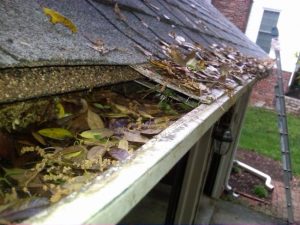Spring brings a bumper crop of seedpods, buds, and flowers
Spring has officially arrived, and that means a multitude of spring chores for homeowners. One of the most important, but often overlooked tasks is checking gutters and downspouts on your home. A properly functioning gutter system protects your home from water damage by draining water from the roof and funneling it away from the house. When the gutters and downspouts are clogged, water can back up and damage the roof, fascia, soffits, and siding. While the fall is the most popular time for gutter cleaning following the leaf drop, the spring is also an ideal time to make sure the gutters are clean, and the downspouts are clear and able to flow properly during heavy spring rains. In the spring, the seedpods, buds, flowers, and leaves all fall into your gutter system. Because of the size of seed pods, tree buds and such, there is a high risk of clogging up the vertical downspouts that are meant to manage the water away from your home.
Spring gutter cleaning process
Prepare to get really, messy
Gutter cleaning isn’t the most enjoyable task in the world. Depending upon how clogged up your rain gutters are, you are most likely going to get dirty and wet. Be sure to wear old clothing (wear a long-sleeved shirt, rubber gloves, safety goggles as well as a dust mask, if you’ve got one.) Get the ladder from the garage, and let’s get started.
First Things, First
Don’t attempt to clean your gutters from the roof. You’d be turning this chore into a needlessly dangerous proposition. A ladder is going to be your best bet. Make sure you’re following best practices for ladder safety. Cleaning out gutters is a simple task, but it can quickly go awry if you aren’t paying attention. Another important reminder for cleaning gutters - don’t reach out further than is safe to do. It’s easy to think you can lean out as far as your body will take you, since it means moving the ladder less. However, remember, keep your waist between the rails. Don’t twist yourself trying to get an extra few inches; the risk isn’t worth it. Since you’re moving the ladder a lot, on potentially unsteady lawns and gardens, also be sure you have stable and even footing; get a spotter if needed If you’re using an extension ladder, it’s a good idea to get what’s called standoff stabilizers. These will prevent the ladder from lying on the gutters themselves, which can cause damage. For collecting the debris (rather than leaving it scattered about your property), you can lay out a tarp underneath your gutters. Just move it along with you when you move the ladder. If using an a-frame ladder, it’s also easy to use a bucket with a handle, which can be attached to one of the built-in hooks on the top of most ladders.
Using a small garden trowel, or just your hands with a pair good gloves, scoop out the leaves and sediment, starting at the downspout. Typically, your hands are the best tool for the job. They are more maneuverable; getting downspout clogs loosened is far easier with hands than a trowel.
Once you have the debris cleared, use a garden hose to spray the remaining particles toward the downspout. Spray the gutters until the water flows freely to the ground and away from your property. Be sure to pay attention to your downspouts to make sure it’s not blocked. If the hose does not do the trick, you may need to use an auger.
Once Your Gutters and Downspouts are Clean
Once all of the debris has been removed, inspect the entire gutter system. Do the rain gutter spikes go through the gutter, through the fascia board and into the rafter behind it? If any are weakened, consider replacing at this time. Since you’ll already be up on the ladder, it is a good time to check for any leaks triggered by holes in the gutters or broken caulking in the seams. Consider using a new bead of silicone sealing to secure the location in between the gutters and the potentially decaying boards. Finally, remember to be sure that all water run-off from the home is slopped and running away from your home. Water always has a way to find the path of least resistance, and that path us usually into the walls of your house, so a leaky gutter can be just as bad as a clogged one.

